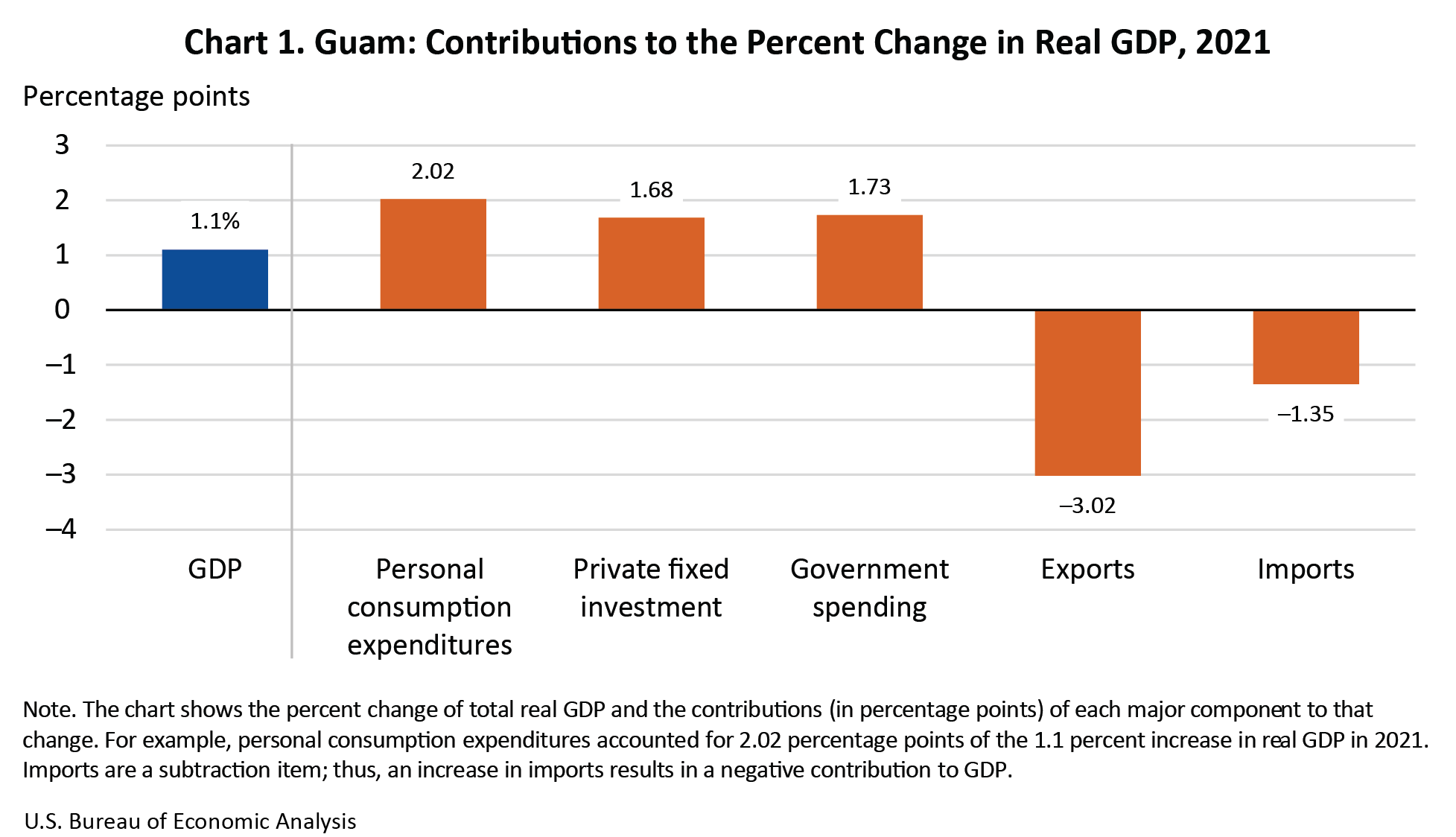News Release
Gross Domestic Product for Guam, 2021
Gross Domestic Product by Industry and Compensation by Industry, 2020
Real gross domestic product (GDP) for Guam increased 1.1 percent in 2021 after decreasing 11.4 percent in 2020 (table 1.3), according to statistics released today by the U.S. Bureau of Economic Analysis (BEA). These statistics were developed under the Statistical Improvement Program funded by the Office of Insular Affairs (OIA) of the U.S. Department of the Interior.
GDP for 2021
The increase in real GDP reflected increases in personal consumption expenditures, government spending, and private fixed investment (table 1.4). These increases were partly offset by a decline in exports of goods and services. Imports, a subtraction item in the calculation of GDP, increased.
Personal consumption expenditures increased 3.3 percent (table 1.3), primarily reflecting growth in spending on durable goods, such as motor vehicles. Consumer spending was supported by government assistance payments distributed to households through the CRRSA Act and the American Rescue Plan Act.
Government spending increased 2.6 percent (table 1.3), primarily reflecting growth in territorial government spending. Territorial government spending increased 5.8 percent. The increase in spending was supported by federal grant revenues, including Coronavirus Relief Fund payments and Education Stabilization Fund payments authorized by the CARES Act and the American Rescue Plan Act.
Private fixed investment increased 6.8 percent (table 1.3), reflecting growth in equipment and structures. Private-sector construction projects included retail outlets and multiunit residential developments.
Exports of goods and services decreased 49.2 percent (table 1.3). The decrease in exports was accounted for by exports of services, which consists primarily of spending by visitors. Data from the Guam Visitors Bureau arrival summary reports show that visitor arrivals declined 75.8 percent, reflecting the continued effects of the COVID–19 pandemic.
GDP by industry and compensation by industry for 2020
In 2020, real GDP decreased 11.4 percent. The newly available GDP by industry data, which are released on a 1-year lag, reveal that the private sector was the source of decline in real GDP in 2020 (table 2.5).
The private sector decreased 18.8 percent (table 2.4), primarily reflecting a decline in accommodations, food services, and amusements. Data from the Guam Visitors Bureau arrival summary reports show that visitor arrivals declined 80.3 percent in 2020. Wholesale and retail trade also decreased, as nonessential businesses throughout Guam were subject to mandatory reductions in operations due to the COVID–19 pandemic.
The government sector increased 1.4 percent (table 2.4), primarily reflecting growth in compensation for federal government employees.
Total compensation decreased from $3,557 million to $3,526 million in 2020 (table 2.6). The $31 million decrease reflected a decline in private-sector compensation. The largest contributor to the decline was accommodations, food services, and amusements.
Estimates for 2018–2020 that were released on December 1, 2021, have been revised to incorporate updates to source data, including the following:
- Audited financial statements for the Government of Guam and its independent agencies,
- Federal government contract obligations data from the U.S. General Services Administration Federal Procurement Data System,
- Annual reports from the Guam Insurance Commissioner, and
- Wage and employment information from the U.S. Census Bureau County Business Patterns.
The revised estimates exhibit a pattern of inflation-adjusted GDP growth similar to the previously published estimates (table 1.7).
Due to lags in the availability of data for various components of GDP, the statistics presented today for 2021 are preliminary estimates. For example, data covering government spending and business receipts by industry for the fourth quarter of 2021 were not available in time for incorporation into this year's estimates of GDP. As additional source data become available, BEA will incorporate the information and will release updated estimates once a year.
For more information on the data sources underlying these estimates, see Summary of Methodologies: Gross Domestic Product for American Samoa, the Commonwealth of the Northern Mariana Islands, Guam, and the U.S. Virgin Islands.
Next release: Fall 2023
Gross Domestic Product for Guam, 2022
Guam GDP by Industry and Compensation by Industry, 2021
